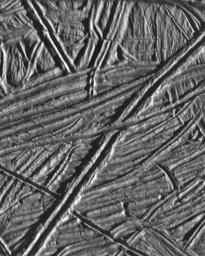
|
Europa Under Stress
- Click the image above for a larger view
- Full-Res JPEG (800 x 1000) (129.7 kB)
- Full-Res TIFF (800 x 1000) (841.3 kB)
Caption:
This high resolution image of the icy plains on Europa shows multiple sets of cross-cutting ridges. Many of these ridges are cut by younger fractures. Fractures that display relative motion are known as faults; several faults showing horizontal motion, like the San Andreas Fault in California, are seen here.
Faults and ridges give planetary geologists clues to the stresses within the crust at the time of formation. Ridges typically form as a result of compression. The orientation of the compressive stress is perpendicular to the strike (long axis) of the ridge. In contrast, fractures form as a result of tensional stresses that crack the brittle crust. These features indicate that the surface of Europa has experienced repeated episodes of tension and compression throughout its history.
This image is approximately 12 kilometers (7 miles) by 15 kilometers (9 miles) across, centered near 15N, 273W. The Galileo spacecraft obtained this image on February 20, 1997 during its sixth orbit of Jupiter from a distance of 2000 kilometers (1240 miles). North is toward the top of the image, with the sun illuminating the surface from the right.
Background Info:
The Jet Propulsion Laboratory, Pasadena, CA manages the mission for NASA's Office of Space Science, Washington, DC.
This image and other images and data received from Galileo are posted on the World Wide Web, on the Galileo mission home page at URL http://galileo.jpl.nasa.gov. Background information and educational context for the images can be found at http://www.jpl.nasa.gov/galileo/sepo .
Cataloging Keywords:
| Name | Value | Additional Values |
|---|---|---|
| Target | Europa | Jupiter |
| System | Jupiter | |
| Target Type | Satellite | Planet |
| Mission | Galileo | |
| Instrument Host | Galileo Orbiter | |
| Host Type | Orbiter | |
| Instrument | Solid-State Imaging (SSI) | |
| Detector | ||
| Extra Keywords | Grayscale | |
| Acquisition Date | ||
| Release Date | 1998-03-26 | |
| Date in Caption | 1997-02-20 | |
| Image Credit | NASA/JPL | |
| Source | photojournal.jpl.nasa.gov/catalog/PIA00850 | |
| Identifier | PIA00850 | |
